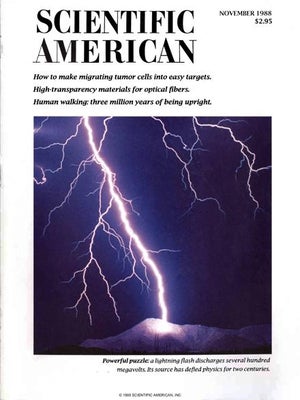Educating Poor Minority Children
Schools must win the support of parents and learn to respond flexibly and creatively to students' needs. A successful program developed in New Haven points the way

You are currently logged out. Please sign in to download the issue PDF.
Schools must win the support of parents and learn to respond flexibly and creatively to students' needs. A successful program developed in New Haven points the way
Not quite periodic, not quite random fluctuations in X-ray intensity provide clues to the nature of extremely bright X-ray sources loosely clustered near the center of our galaxy
The cells that spread cancer throughout the body have distinctive molecular traits. Already cancer researchers know enough about those traits to convert malignant cells into benign ones
Although it has been known for two centuries that lightning is a form of electricity, the exact microphysical processes responsible for the charging of storm clouds remain in dispute
Liquid helium cooled to within 2.172 degrees of absolute zero can flow without viscosity or friction, but seldom without turbulence. The odd form of turbulence that arises is quantum-mechanical in nature
New glass and crystalline fibers, promising greater transparency and transmitting longer wavelengths than silica fibers, have been applied to communication systems, medical diagnostics and optical-fiber lasers
Features of her pelvis show that a three-million-year-old hominid, Lucy, was as adept at upright walking as we are. Bipedality could date from the earliest phase of human evolution
Six vaccines are already in use there. Many others could be produced within 10 years. Yet those who have the know-how to make the needed vaccines have lacked incentives to apply it